In recent years, Elon Musk’s Starlink initiative has opened up a new frontier in global connectivity, providing high-speed internet even to the most remote corners of the world. However, the rapid expansion of this satellite network has introduced a host of unforeseen challenges, particularly in the field of astronomy. The Netherlands Institute for Radio Astronomy (ASTRON) has sounded alarms regarding the interference caused by the growing fleet of Starlink satellites, highlighting a conflict that poses a serious threat to astronomical research and understanding of the cosmos.
Starlink’s second-generation satellites, known as V2, have emitted electromagnetic radiation at levels that are as much as 32 times stronger than their predecessors. This significant increase in interference has become an obstructive force for radio telescopes that are crucial for observing distant cosmic phenomena such as black holes, galaxies, and exoplanets. The challenge lies in the fact that these satellites, stationed approximately 550 kilometers above the Earth’s surface, create a cacophony in the radio spectrum—turning the once serene backdrop of space into a chaotic storm of noise that blinds astronomers to the faint signals they aim to capture.
Cees Bassa, a leading researcher in this area, has aptly described the interference akin to the brightness of a full moon—drowning out the subtle glimmers of stars that astronomers have worked tirelessly to study. This analogy encapsulates the severity of the issue, making it abundantly clear that the very tools and technologies developed to enhance our understanding of the universe are being compromised.
With estimates suggesting that the number of Starlink satellites could soar past 100,000 by the year 2030, astronomers are increasingly demanding urgent action. Robert Massey, Deputy Executive Director of the Royal Astronomical Society in the UK, has voiced concerns that the situation must be addressed promptly. His call for immediate corrective measures from SpaceX emphasizes the prevailing anxiety among the astronomical community, who regard the unchecked expansion of Starlink as not just a nuisance, but a genuine existential threat to ground-based astronomical research.
Experts propose several solutions to mitigate the interference, including the shielding of satellite batteries and improving the overall design to reduce radiation emissions. Such proactive measures could significantly improve the situation, allowing for the continued exploration of deep space without the intrusive interruption of satellite noise.
As we advance further into an era dominated by commercial space operations, the role of large satellite providers like SpaceX becomes increasingly pivotal. The decisions made by these companies not only shape technological landscapes but also carry implications for scientific inquiry and knowledge. Scientists are urging the need for responsible space operations—one that harmonizes commercial success with the preservation of scientific integrity.
If unresolved, the interference caused by Starlink could impose severe limitations on our ability to observe the universe. As more satellites fill the skies, it is crucial for stakeholders to strike a balance that accommodates both the wonders of connectivity and the pursuit of cosmic knowledge. The onus now lies on SpaceX to lead the industry toward solutions that foster coexistence rather than conflict, a step that can set a vital precedent for future endeavors in space exploration.


Leave a Reply